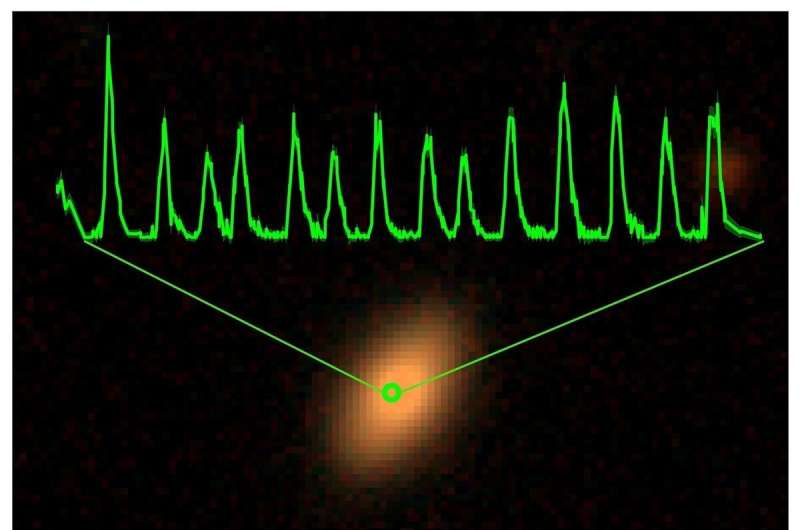eROSITA witnesses the awakening of massive black holes

Using the SRG/eROSITA all-sky survey data, scientists at the Max Planck Institute for Extraterrestrial Physics have found two previously quiescent galaxies that now show quasi-periodic eruptions. The nuclei of these galaxies light up in X-rays every few hours, reaching peak luminosities comparable to that of an entire galaxy. The origin of this pulsating behavior is unclear. A possible cause is a stellar object orbiting the central black hole. As these galaxies are relatively close and small, this discovery could help scientists to better understand how black holes are activated in low-mass galaxies.
Quasars or “active galactic nuclei” (AGN) are often called the lighthouses of the distant universe. The luminosity of their central region, where a very massive black hole accretes large amounts of material, can be thousands of times higher than that of a galaxy like our Milky Way. However, unlike a lighthouse, AGN shine continuously.
“In the eROSITA all-sky survey, we have now found two previously quiescent galaxies with huge, almost periodic sharp pulses in their X-ray emission,” says Riccardo Arcodia, Ph.D. student at the Max Planck Institute for Extraterrestrial Physics (MPE), who is the first author of the study now published in Nature. These kinds of objects are fairly new: only two such sources were known before, found either serendipitously or in archival data in the past couple of years. “As this new type of erupting sources seems to be peculiar in X-rays, we decided to use eROSITA as a blind survey and immediately found two more,” he adds.
The eROSITA telescope currently scans the entire sky in X-rays and the continuous data stream is well suited to find transient events such as these eruptions. Both new sources discovered by eROSITA showed high-amplitude X-ray variability within just a few hours, which was confirmed by follow-up observations with the XMM-Newton and NICER X-ray telescopes. Contrary to the two known similar objects, the new sources found by eROSITA were not previously active galactic nuclei.
“These were normal, average low-mass galaxies with inactive black holes,” explains Andrea Merloni at MPE, principal investigator of eROSITA. “Without these sudden, repeating X-ray eruptions we would have ignored them.” The scientists now have the chance to explore the vicinity of the smallest super-massive black holes. These have 100 000 to 10 million times the mass of our Sun.
Quasi-periodic emission such as the one discovered by eROSITA is typically associated with binary systems. If these eruptions are indeed triggered by the presence of an orbiting object, its mass has to be much smaller than the black hole’s—of the order of a star or even a white dwarf, which might be partially disrupted by the huge tidal forces close to the black hole at each passage.
Optical image of the second galaxy found with quasi-periodic eruptions in the eROSITA all-sky data, the XMM-Newton X-ray light-curve is overlayed in magenta. The galaxy was identified as 2MASX J02344872-4419325 at a redshift of z~0.02. This source shows much narrower and more frequent eruptions, approximately every 2.4 hours. Credit: MPE; optical image: DESI Legacy Imaging Surveys/D. Lang (Perimeter Institute)
“We still do not know what causes these X-ray eruptions,” admits Arcodia. “But we know that the black hole’s neighborhood was quiet until recently, so a pre-existing accretion disk as the one present in active galaxies is not required to trigger these phenomena.” Future X-ray observations will help to constrain or rule out the “orbiting object scenario” and to monitor possible changes in the orbital period. These kinds of objects could also be observable with gravitational waves signals, opening up new possibilities in multi-messenger astrophysics.



 Creators of mankind
Creators of mankind Description of “Tall white aliens”
Description of “Tall white aliens” Where they came from?
Where they came from? About hostile civilizations
About hostile civilizations The war for the Earth
The war for the Earth “Tall white aliens” about eternal life
“Tall white aliens” about eternal life Video: “Nordic aliens”
Video: “Nordic aliens” Aliens
Aliens Alien encounters
Alien encounters The aliens base
The aliens base UFO
UFO Technology UFO
Technology UFO Underground civilization
Underground civilization Ancient alien artifacts
Ancient alien artifacts Military and UFO
Military and UFO Mysteries and hypotheses
Mysteries and hypotheses Scientific facts
Scientific facts


















